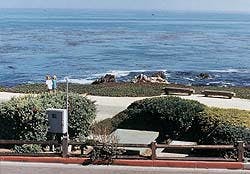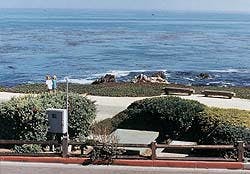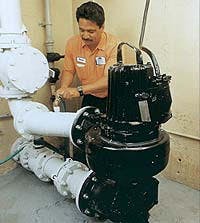Pumps Eliminate Lift Station Blockage Problems
Monterey Regional Water Pollution Control Agency (MRWPCA) has installed a new type of pump featuring a self-cleaning impeller to overcome frequent clogging experienced in recent years at Pacific Grove Station 12.
Prior to replacing the station's two original pumps, the wetwell's limited retention and close proximity to Monterey Bay 60 feet away increased the risk of bypasses reaching the beach, said Mark Malanka, program coordinator with the MRWPCA's Field Maintenance Division. The City of Pacific Grove, CA, is one of several municipalities that contract with MRWPCA to maintain their lift stations.
"Station 12 experienced increased clogging, parts failures and general deterioration during the years immediately prior to the pump replacement," Malanka said. "Six or more times a year the impellers would become clogged, setting up emergency situations. In addition, we had to dismantle and clean the pumps about every six months when they became caked with grease, straws and other residue in the waste from the many restaurants and bars in the area. Maintenance was made even more difficult by a lack of replacement parts for the old pumps."
The station was designed 20 years ago as a plug flow dry side/wet side facility with an 8 inch wetwell inlet and 6 inch outlet on the force main side. The drywell of the 20 foot deep facility was equipped with two 300 gpm pumps with constant-speed motors.
The coastal communities in this area of Central California have since undergone tremendous population growth and development. Under typical summer conditions, the motors could still handle the flow and ran approximately six hours per day. During the average 20 inches of rainfall in the area during winter months, the station's old pumps could not handle the increased flow and ran around the clock. A trailer-mounted, 1.1 mgd auxiliary pump was often staged nearby for additional standby capacity during periods of peak flow.
Over a period of four years the station's increasing structural deterioration, blockages and generally high maintenance and operating cost set the stage for the recent upgrades after plans for an even more comprehensive retrofit were shelved when the city lost the funding. Although more limited in scope than the $200,000 project that was originally envisioned, MRWPCA convinced the city to commit $30,000 to cover labor charges, the state-of-the-art pumps, a new control panel, and associated upgrades to the emergency generator, level system and modified bypass system. The agency also linked the station with the agency's SCADA, a significant improvement over the simple 9-volt alarm.
Shape, Inc., a distributor for ITT Flygt pumps, assessed the situation and recommended replacing the old single-vane sewage pumps with ITT Flygt Model N-3127 units.
The recently developed wastewater-handling pumps feature a hydraulic design that ensures efficient pumping over prolonged periods of continuous operation. The design of the semi-open, screw-shaped impeller greatly reduces the risk of clogging by its ability to maintain unobstructed impeller-vane leading edges.
Laboratory tests and field experience reveal that most frequently, pump clogging begins with the fouling of the leading edges of the pump impellers. During pump operation, each leading edge of the rotating N-pump impeller passes across a sharp stationary relief-groove located in the pump suction. This dynamic action ensures that rags, stringy materials and solids are sheared, cleaned from the impeller and pumped away. The impeller is ideally suited for pumping stations whose flows contain fibrous materials, grease and solids as well as for the pumping of various types of sludge waste.
Retrofit installations that use variable speed N-pumps have eliminated chronic pump clogging problems and also have delivered energy savings as great as 50 percent. Increased efficiency translates into lower overall energy consumption, a significant factor in reducing the whole-life cost of a pumping station.
Shape's field technicians also recommended substituting the existing 300 gpm units with 500 gpm N-pumps.
"As it turned out, it only cost us $6000 to replace each pump versus the $3000 apiece to just repair the bowls at the bottom of the wetwell on two earlier occasions," Malanka said. The entire project was handled by a MRWPCA self-directed work team.
"We have not had a clogging problem or threat of a bypass since the new pumps were installed," Malanka said.
"The new pumps have also eliminated the frequent grease buildup on the old pumps' impellers that would drop their efficiency by at least 40 percent," he added. "The 500 gpm units run about an hour less per day during summer months and 25 percent less during peak winter run times than the previous 300 gpm pumps. We have therefore gained greater reliability and better overall operating efficiency."
Established in 1972, MRWPCA presently serves a dozen communities and outlying, unincorporated areas of Monterey County. Station 12 is one of 27 pump stations and 35 air release facilities now in place along 35 miles of force mains. The infrastructure is linked with MRWPCA's 29.6 mgd wastewater treatment plant.
Completed in 1990, the plant was recently honored as Plant of the Year for facilities rated over 10 mgd by the California Water Environment Association. The award recognizes a number of initiatives involving the plant operations. The facility co-generates all of its electricity from methane off the treatment process and often produces enough energy to have surplus to sell to Pacific Gas & Electric. The cogeneration program saves an estimated $500,000 per year and is one of many operating efficiencies that have kept the residential rate at $9.60 per month for the past decade, Malanka said.
MRWPCA also participates in an ambitious subscriber-based recycling water program. In 1992 a partnership between MRWPCA and the Monterey County Water Resources Agency was established to build a water recycling plant and distribution system at the wastewater treatment facility. Originally, the program was created to help arrest seawater intrusion into the Monterey County aquifers, then stressed by draws for agricultural irrigation.
The subscriber-based program has produced $75 million worth of infrastructure 45 miles of pipeline and 21 supplemental wells to recycle all 21 mgd of the plant's effluent after it undergoes primary, secondary, and tertiary treatments. The plant recycles about 12,000 ac/ft. per year of clear, odorless and safe irrigation water for 12,000 acres planted with lettuce, cauliflower, artichokes, and other raw salad crops.
The self-supported recycling program has all but eliminated discharging treated effluent two miles out into the deep sanctuary of Monterey Bay for much of the year. The investment has helped to stabilize the aquifers and provided a vital resource to the participating growers. Public works officials from as far away as the Republic of China have visited the plant and the recycling facilities. WW/


